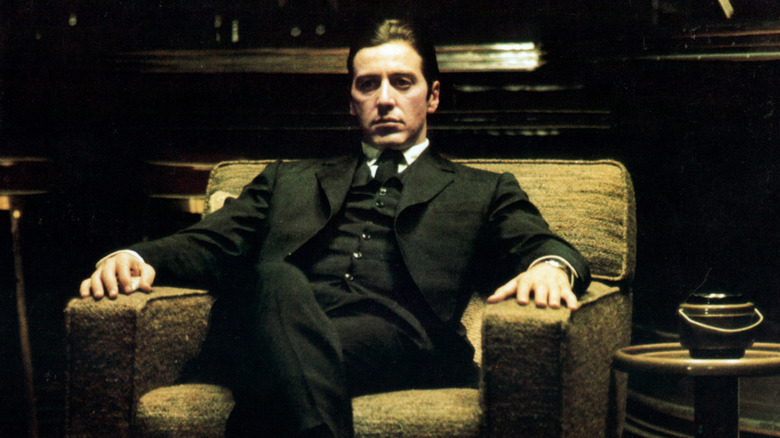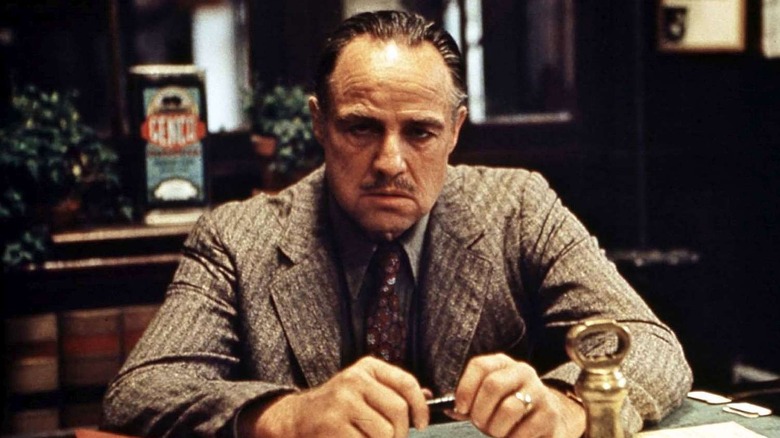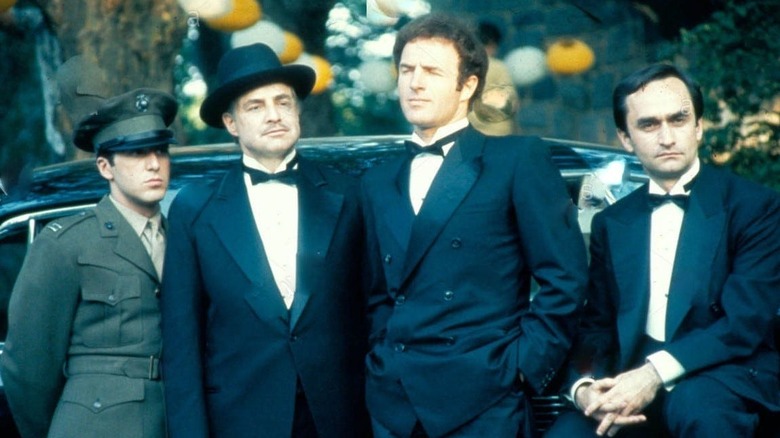Francis Ford Coppola's Godfather Trilogy Exists Thanks To George Lucas
Francis Ford Coppola's "The Godfather" and "The Godfather Part II" are such mighty landmarks of American cinema that it feels like they must have been inevitably destined for the screen. Perhaps the less said about the third part, the better, but it's a testament to the enduring power of Coppola's first two chapters that it did little to tarnish the reputation of the originals. Yet "The Godfather" was a film that, at the time, nobody was very interested in making at all, and we have George Lucas's influence to thank for its existence.
In the early '60s, the American public had become familiar with the inner workings of the Mob thanks to a high-profile Senate committee's investigation into organized crime, during which Genovese soldier-turned-informant Joe Valachi became the first family member to openly acknowledge the Mafia's existence. A few years later, author Mario Puzo decided to cash in, writing a novel tentatively titled "Mafia" in the hopes of clearing his gambling debts — the hook was that the word had never been used in a book or movie title before.
Paramount Head of Production Robert Evans reluctantly took a punt optioning the book, but what Puzo received for the rights turned out to be a pittance. Re-named "The Godfather" for publication, the novel was a smash hit and spent 67 weeks in the New York Times best-seller list. Evans had landed a bargain, but even then, very few people in Hollywood were enthused about turning Puzo's pulpy gangster saga into a feature film. It would take the failure of another venture in a totally different genre to set it on course for legendary status, which is where George Lucas comes in.
Francis Ford Coppola was not first choice to direct The Godfather
It might seem unbelievable that "The Godfather" wasn't considered a surefire winning prospect now, but gangster movies had a pretty low status back in the 1960s. They weren't viewed as commercially viable, especially after "The Brotherhood" (starring a woefully miscast Kirk Douglas) bombed at the box office. But after securing the first option to Puzo's novel, Evans and Paramount were spurred into action by Burt Lancaster, who was reportedly ready to make a bid of $1 million for "The Godfather" rights with a view to playing Don Corleone himself.
Evans put the project in the hands of producer Al Ruddy, tasking him with bringing the 1940s-era story into a contemporary setting to keep costs down while also making it so authentic that you could "smell the spaghetti." Finding somebody to actually direct the film proved a challenge; Arthur Penn, Otto Preminger, Peter Bogdanovich, Orson Welles, and Sergio Leone were all among the respected names who turned it down before Paramount looked at Francis Ford Coppola.
At that point, Coppola's biggest hit was "Finian's Rainbow," and he was considered a good bet because he was Italian-American and he'd probably do the job for little money. The problem was, Coppola didn't want to make "The Godfather" either, considering Puzo's novel a little too lowbrow for his taste. The search for a director might well have continued if it wasn't for George Lucas, who had visited the set of "Finian's Rainbow" as a USC student. Despite disliking Coppola's musical, the two became friends and formed their own production company, American Zoetrope, to make indie films outside the ailing Hollywood studio system. But Lucas's debut feature quickly put Zoetrope in hock, and they needed money fast.
Lucas's failure was key to Coppola's success
American Zoetrope secured a seven-picture contract with Warner Bros. and pinned its hopes on George Lucas' first feature film, "THX 1138," but the studio executives were not impressed and insisted on cuts. To make matters worse, the film flopped at the box office, Warners canceled the deal, and sued Coppola for money he'd already spent setting up Zoetrope. Finding themselves in financial difficulty, Lucas urged Coppola to take "The Godfather" gig to clear the debt and ensure the future of their studio.
To his credit, Coppola didn't just half-ass it when he finally signed up. He now envisioned the picture as an epic tale of succession and American Capitalism, insisting on making it a period piece filmed on location in New York. That meant the budget went up and Al Ruddy needed to placate the head of the Colombo Family, who had already led New York's Italian-American community in protest against discrimination by the FBI. Behind the scenes, Coppola also had to wrangle the producers in order to land his casting picks of Marlon Brando and Al Pacino as Don Corleone and his son Michael respectively.
Needless to say, it all worked out okay. "The Godfather" was a box office sensation and won the Oscar for Best Picture, and Coppola's follow up, "The Godfather Part II" received even greater acclaim despite relatively modest ticket sales, becoming the first sequel to win Best Picture and also earning Coppola the award for Best Director. Meanwhile, George Lucas made "American Graffiti," a Best Picture-nominee that opened the door for his own rather well-known trilogy. Overall, the failure of "THX 1138" emerged as the making of both filmmakers, and helped change the course of American cinema.


